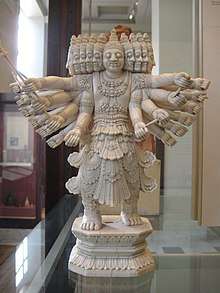Rakshasa
Rakshasa (Sanskrit: राक्षस, rākṣasa) is a supernatural being in Hindu mythology. As this mythology influenced other religions, the rakshasa was later incorporated into Buddhism. Rakshasas are also called "man-eaters" (nri-chakshas, kravyads). A female rakshasa is known as a rakshasi. A female rakshasi in human form is a rakshesha. The terms asura and rakshasa are sometimes used interchangeably.
 Rakshasa as depicted in Yakshagana, an art form of Uttara Kannada. Artist: Krishna Hasyagar, Karki | |
| Grouping | Legendary creature |
|---|---|
| Sub grouping | Demigod |
| Other name(s) |
|
| Country | India, Bangladesh, Nepal, Sri Lanka, Myanmar, Thailand, Laos and Cambodia |
Hindu lore
Vedic and Puranic stories
Rakshasas were believed to have been created from the breath of Brahma when he was asleep at the end of the Satya Yuga. As soon as they were created, they were so filled with bloodlust that they started eating Brahma himself. Brahma shouted "Rakshama!" (Sanskrit for "Protect me!") and Vishnu came to his aid, banishing to Earth all Rakshasas (named after Brahma's cry for help).
Their literary origins can be traced to Vedic sources through Hymn 87 of the tenth mandala of the Rigveda. They are classified amongst the Yatudhanas, mythological beings that consume raw flesh.[1][2]
Description
Rakshasas were most often depicted as shape-shifting, fierce-looking and enormous creatures, with two fangs protruding from the top of the mouth and having sharp, claw-like fingernails. They are shown as being mean, growling like beasts, and as insatiable man-eaters that could smell the scent of human flesh. Some of the more ferocious ones were shown with flaming red eyes and hair, drinking blood with their palms or from a human skull (similar to representations of vampires in later Western mythology). Generally they could fly, vanish, and had Maya (magical powers of illusion), which enabled them to change size at will and assume the form of any creature. The female equivalent of rakshasa is rakshasi.[3]
In Hindu epics

In the world of the Ramayana and Mahabharata, Rakshasas were a populous race. There were both good and evil rakshasas, and as warriors they fought alongside the armies of both good and evil. They were powerful warriors, expert magicians and illusionists. As shape-changers, they could assume different physical forms. As illusionists, they were capable of creating appearances which were real to those who believed in them or who failed to dispel them. Some of the rakshasas were said to be man-eaters, and made their gleeful appearance when the slaughter on a battlefield was at its worst. Occasionally they served as rank-and-file soldiers in the service of one or another warlord.
Aside from its treatment of unnamed rank-and-file Rakshasas, the epics tell the stories of certain members of the "race" who rose to prominence, some of them as heroes, most of them as villains.
In the Ramayana
The Battle of Sri Lanka pitted an army of Rakshasas under Ravana against an army of Vanaras, under Rama and Sugriva.
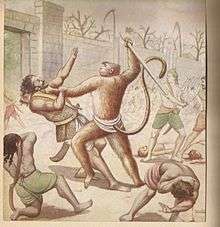
- Ravana was the King of Lanka. He was the commander of the Rakshasas. He was the immortal enemy of Rama, the hero of the Ramayana. In the Mahabharata (Book III: Vana Parva, Section 271 ff.), the Sage Markandeya recounts the story of how Ravana kidnapped Rama's wife Sita and whisked her off to his stronghold Lanka. Rama, aided by the monkey King Sugriva and his army of monkeys, laid siege to Lanka, slew Ravana, and rescued Sita.
- Vibhishana was Ravana's younger brother. He was beautiful, pious and assiduous in his religious observances. When Brahma granted him a boon, he asked never to swerve from the path of righteousness and to always be illumined by divine knowledge (Book III, Vana Parva: Section 273.) Vibhishana joined Rama in his campaign against Ravana and helped Rama's army to cross the ocean into Lanka (Section 281). When invisible Rakshasas infiltrated Rama's camp, Vibhishana caused them to become visible; this enabled Rama's monkey soldiers to destroy them (Section 283). After Rama's final victory over Ravana, the loyal Vibhishana was made king of Lanka and remaining Rakshasas (Section 289).
.jpg) The mural of the Temple of the Emerald Buddha depicting an event in Rammakian, a Thai version of the Hindu epic Ramayana. In this photo, Rama and his younger brother, Lak (Lakshmana), attend a meeting with the magus, Phiphek (Vibhishana) and the monkey military chiefs.
The mural of the Temple of the Emerald Buddha depicting an event in Rammakian, a Thai version of the Hindu epic Ramayana. In this photo, Rama and his younger brother, Lak (Lakshmana), attend a meeting with the magus, Phiphek (Vibhishana) and the monkey military chiefs. - Kumbhakarna was another brother of Ravana; he was sometimes referred to as a Rakshasa because of his frightening appearance and size. Like Rakshasas, he had an enormous appetite and ate large quantities of food and meat. A fearsome warrior and master of illusion, he slept through most of the Battle of Lanka (having long before requested and received a gift of long-lasting sleep from Brahma). When Ravana awakened him with alarming news about the conflict, he arose and took the field. Upon marching out of the city, Kumbhakarna was immediately swarmed by Rama's monkeys; he just laughed and wreaked great mayhem amidst them. When the monkey king Sugriva attacked, Kumbhakarna grabbed him and started to drag him off. At that point Rama and his brother Lakshmana used arrows and a secret Brahmastra ("Brahma's weapon") to kill Kumbhakarna, dropping him "like a huge tree cleft in twain by a thunderbolt." (Ramayana, Book III: Vana Parva, Section 285.)
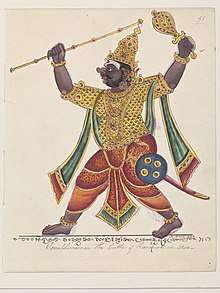 Kumbhakarna
Kumbhakarna
Other Rakshasas that are featured in the Ramayana include Indrajit, Shurpanakha, Kaikashi, Sumali, Kabandha, Tataka (sometimes called Taraka), Maricha, Subahu, Khara, Akshayakumara, Atikaya, Prahasta, Jambumali etc.
In the Mahabharata
The Pandava hero Bhima was the nemesis of forest-dwelling Rakshasas who dined on human travellers and terrorized human settlements.
- Bhima killed Hidimba, a cannibal Rakshasa. The Mahabharata (Book I: Adi Parva, Section 154) describes him as a cruel cannibal with sharp, long teeth and prodigious strength. When Hidimba saw the Pandavas sleeping in his forest, he decided to eat them. He sent his sister Hidimbi to reconnoiter the situation, and the young woman fell in love with the handsome Bhima, whom she warned of danger. Infuriated, Hidimba declared he was ready to kill not only the Pandavas but also his sister, but he was thwarted by the heroism of Bhima, who defeated and killed him in a duel.
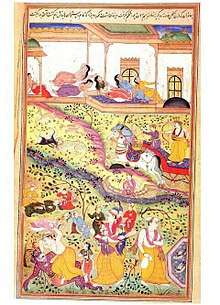
- Ghatotkacha, a Rakshasa who fought on the side of the Pandavas, was the son of Bhima and the Rakshasa Hidimbi, who had fallen in love with the hero and warned him of danger from her brother. Bhima killed the evil Rakshasa Hidimba. Their son's name refers to his round bald head; ghata means 'pot' and utkacha means 'head' in Sanskrit. Ghatotkacha is considered a loyal and humble figure. He and his followers were available to his father Bhima at any time; all Bhima had to do was to think of him and he would appear. Like his father, Ghatotkacha primarily fought with the mace. His wife was Ahilawati and his sons were Anjanaparvana and Meghavarna.
In the Mahabharata, Ghatotkacha was summoned by Bhima to fight on the Pandava side in the Kurukshetra War. Invoking his magical powers, he wrought great havoc in the Kaurava army. In particular, after the death of Jayadratha, when the battle continued on past sunset, his powers were at their most effective (at night). After performing many heroic deeds on the battlefield and fighting numerous duels with other great warriors (including the Rakshasa Alamvusha, the elephant-riding King Bhagadatta, and Aswatthaman, the son of Drona), Ghatotkacha encountered the human hero Karna. At this point in the battle, the Kaurava leader Duryodhana had appealed to his best fighter, Karna, to kill Ghatotkacha, as the entire Kaurava army was near annihilation due to his ceaseless strikes from the air. Karna possessed a divine weapon, Shakti, granted by the god Indra. It could be used only once and Karna had been saving it to use on his arch-enemy Arjuna, the best Pandava fighter. Unable to refuse Duryodhana, Karna used the Shakti against Ghatotkacha, killing him. This is considered to be the turning point of the war. After his death, the Pandava counselor Krishna smiled, as he considered the Pandava prince Arjuna to be saved from certain death, as Karna had used the Shakta divine weapon. A temple in Manali, Himachal Pradesh, honors Ghatotkacha; it is located near the Hidimba Devi Temple.
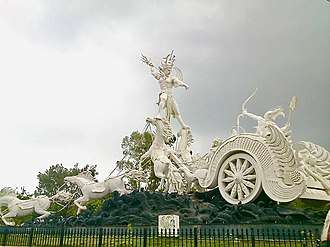
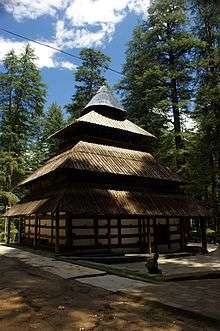
- Bakasura was a cannibalistic forest-dwelling Rakshasa who terrorized the nearby human population by forcing them to take turns making him regular deliveries of food, including human victims. The Pandavas travelled into the area and took up residence with a local Brahmin family. Their turn came when they had to make a delivery to Bakasura, and they debated who among them should be sacrificed. The rugged Bhima volunteered to take care of the matter. Bhima went into the forest with the food delivery (consuming it on the way to annoy Bakasura). He engaged Bakasura in a ferocious wrestling match, and broke his back. The human townspeople were amazed and grateful. The local Rakshasas begged for mercy, which Bhima granted them on the condition that they give up cannibalism. The Rakshasas agreed and soon acquired a reputation for being peaceful towards humans. (Book I: Adi Parva, Sections 159-166.)
.jpg) Krishna killing Bakasura (Demon Crane); Kalighat Pattachitra style, Bengal.
Krishna killing Bakasura (Demon Crane); Kalighat Pattachitra style, Bengal. - Kirmira, the brother of Bakasura, was a cannibal and master illusionist. He haunted the wood of Kamyaka, dining on human travellers. Like his brother before him, Kirmira also made the mistake of fighting the Pandav hero Bhima, who killed him with his bare hands (Book III: Varna Parva, Section 11).
- Jatasura was a cunning Rakshasa who, disguised as a Brahmin, attempted to steal the Pandavas' weapons and to ravish Draupadi, wife of the five Pandavas. Bhima arrived in time to intervene, and killed Jatasur in a duel. (Book III: Varna Parva, Section 156). Jatasur's son was Alamvush, who fought on the side of the Kauravas at Kurukshetra.
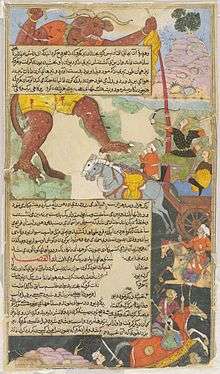
Rakshasa heroes fought on both sides in the Kurukshetra war.
- Alambusha was a Rakshasa skilled at fighting with both conventional weapons and the powers of illusion. According to the Mahabharata, he fought on the side of the Kauravas. Arjuna defeated him in a duel (Book VII: Drona Parva, Section 167), as did Arjuna's son Abhimanyu (Book VI: Bhishma Parva, Section 101–102). But Alamvusha in turn killed Iravan, Arjuna's son by a Nāga princess Ulupi, when the Rakshasa used his powers of illusion to take on the form of Garuda. Alamvusha was also defeated by Bhima (Book VII: Drona Parva, Section 107). He was slain by Bhima's son, the Rakshasa Ghatotkacha (Book VII: Drona Parva, Section 108).
In Buddhist lore
Chapter 26 of the Lotus Sutra includes a dialogue between the Buddha and a group of rakshasa daughters, who swear to uphold and protect the Lotus Sutra. They also teach magical dhāraṇīs to protect followers who also uphold the sutra.[4] In The Lotus-Born: The Life Story of Padmasambhava, recorded by Yeshe Tsogyal, Padmasambhava receives the nickname of "Rakshasa" during one of his wrathful conquests to subdue Buddhist heretics.
In Chinese tradition rakshasa are known as luocha (罗刹).[5]
Jainism lore
Jain accounts vary from the Hindu accounts of Rakshasa. According to Jain literature, Rakshasa was a kingdom of civilized and vegetarian people belonging to the race of Vidyadhara, who were devotees of Tirthankara.[6]
Artistic and folkloric depictions
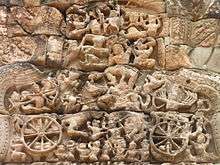
The artists of Angkor in Cambodia frequently depicted Ravana in stone sculpture and bas-relief. The "Nāga bridge" at the entrance to the 12th-century city of Angkor Thom is lined with large stone statues of Devas and Asuras engaged in churning the Ocean of Milk. The ten-headed Ravana is shown anchoring the line of Asuras.[7]
A bas-relief at the 12th-century temple of Angkor Wat depicts the figures churning the ocean. It includes Ravana anchoring the line of Asuras that are pulling on the serpent's head. Scholars have speculated that one of the figures in the line of Devas is Ravana's brother Vibhishana. They pull on a serpent's tail to churn the Ocean of Milk.[8] Another bas-relief at Angkor Wat shows a 20-armed Ravana shaking Mount Kailasa.[9]
The artists of Angkor also depicted the Battle of Lanka between the Rakshasas under the command of Ravana and the Vanaras or monkeys under the command of Rama and Sugriva. The 12th-century Angkor Wat contains a dramatic bas-relief of the Battle of Lanka between Ravana's Rakshasas and Rama's monkeys. Ravana is depicted with ten heads and twenty arms, mounted on a chariot drawn by creatures that appear to be a mixture of horse, lion, and bird. Vibhishana is shown standing behind and aligned with Rama and his brother Lakshmana. Kumbhakarna, mounted on a similar chariot, is shown fighting Sugriva.[10]
This battle is also depicted in a less refined bas-relief at the 12th-century temple of Preah Khan.
In languages
In Indonesian and Malaysian variants of Malay which has significant Sanskrit influence, raksasa now means "giant", "gigantic", "huge and strong";[11] the Malaysian variant recognises the word as an outright official equivalent to "monster"[12] whereas the Indonesian variant uses it more in colloquial usage.[11]
In Bengali, rakh-khosh (রাক্ষস) is used as term for a person who eats incessantly and without need to stop. This derivation also occurs in Malay and Indonesian as rakus, and in Khasi as rakot, which means "greedy".[11]
See also
- Asura
- Daitya
- Danava
- Brahmarakshasa
- List of Rakshasas
- Rakshasa (Dungeons & Dragons)
- Rakshasa (fiction)
Notes
- "Answers - The Most Trusted Place for Answering Life's Questions". Answers.com. Retrieved 7 January 2020.
- Wikisource:The Rig Veda/Mandala 10/Hymn 87
- Gopal, Madan (1990). K.S. Gautam (ed.). India through the Ages. Publication Division, Ministry of Information and Broadcasting, Government of India. p. 72.
- Lotus Sutra, chapter 26, Burton Watson translation Archived 25 March 2003 at Archive.today
- The Contemporary Chinese Dictionary. 2002. ISBN 7-5600-3195-1.
- "Jainism Resource Center - Articles". sites.fas.harvard.edu. Retrieved 7 January 2020.
- Rovedo, p.108.
- Rovedo, pp.108-110; Freeman and Jacques, p.62.
- Freeman and Jacques, p.57.
- Rovedo, pp.116-117.
- Atmosumarto, Sutanto (2004). A learner's comprehensive dictionary of Indonesian. Atma Stanton. p. 445. ISBN 9780954682804.
- "'monster' - Kamus Bahasa Inggeris [English Dictionary]". Pusat Rujukan Persuratan Melayu. Retrieved 20 June 2020.
References
- Freeman, Michael and Claude Jacques (2003). Ancient Angkor. Bangkok: River Books.
- Rovedo, Vittorio (1997). Khmer Mythology: Secrets of Angkor. New York: Weatherhill.
Further reading
- Pollock, Sheldon (1985/1986). "Rakshasas and others" (PDF), Indologica Taurinensia vol. 13, pp. 263–281
External links
| Wikimedia Commons has media related to Rakshasa. |
- The Mahabharata of Vyasa translated from Sanskrit into English by Kisari Mohan Ganguli, online version
